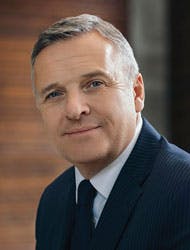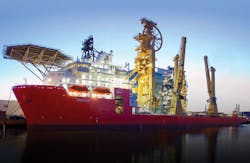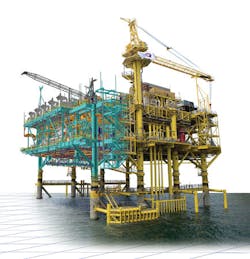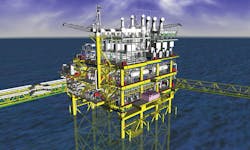Cost management enables company to navigate downturn
Bruce Beaubouef
Managing Editor
At nearly 100 years old, McDermott International, Inc. has been able to survive the periodic downturns and structural re-alignments that afflict the oil and gas industry every decade or so.
And more than just surviving, McDermott has thrived over the past year, in the midst of one of the harshest downturns in the offshore industry’s history. In 2016, the company posted what it describes as “a breakthrough year,” ending the year with $3.0 billion of its projected revenue on backlog and a total backlog of $4.3 billion.
President and CEO David Dickson credits McDermott’s success to its vertically integrated business model, in which the company provides pre-FEED and FEED (front-end engineering and design) services; assembly and fabrication; construction and installation; and the company is investing in technology to position itself for life-of-field services. He also credits that success to the company’s strong relationships with state-owned oil companies in the Middle East, Mexico, India, and the Asia/Pacific region. These relationships, he says, have helped McDermott successfully weather the downturn.
And with the advent of a new software platform (still under development), Dickson says that McDermott will be able to deliver a “digital twin,” or computer model, of the facilities to the client, after installation, to help make future operations and maintenance activities more efficient.
McDermott has also been opportunistic with the downturn, acquiring the deepwater pipelay and construction vesselAmazon at a fraction of its new-build cost. Indeed, “disciplined cost management” has also been key to the company’s success in recent years, Dickson says.
Dickson became Executive Vice President and COO of McDermott in October 2013, and was subsequently appointed President and CEO in December 2013. He has more than 24 years of offshore oilfield engineering and construction business experience, including 11 years of experience with Technip S.A. and its subsidiaries. Prior to Technip, Dickson headed operations at CNS Subsea Ltd.; was operations manager at ETPM DeepSea Ltd.; and worked for McDermott in the UK in the late 1990s.
Offshore recently met with Dickson to discuss McDermott’s recent offshore E&P activities, the state of the offshore oil and gas market, and its strategies for navigating the downturn.
Offshore: How do you assess the current offshore oil and gas market, particularly the demand for EPCI services?
Dickson: We think we’re at the bottom now, and things are gradually beginning to look up. We see good opportunities in places also like the Middle East, where we are very strong today. But, we see even more opportunity in places such as Mexico and India. A lot of this is shallow water, and we have a lot of activity in shallow-water areas. For the deepwater regions, we believe that operators and state-owned entities will be making more final investment decisions in 2018 to 2020, and beyond. That’s generally how we’re seeing the market at the moment.
Offshore: What strategies has McDermott used to stay busy during this down cycle?
Dickson:When the downturn began a couple of years ago, we decided to focus on those geographies where the cost to extract a barrel of oil is competitive with lower oil prices. This meant emphasizing areas with national oil companies. So if you look at our backlog, and you look at our customer base, it includes Saudi Aramco, Qatar Petroleum, ONGC of India, and PEMEX. Those companies make up two-thirds of our backlog today, probably even more.
At the same time, our backlog with the supermajors is probably at a record low. That is a reflection of their lower capex budgets over the past two years. So we recognized where we need to focus our energies. Some analysts have said: “Hey, you’ve got probably too much work in your backlog from Aramco.” And we would reply: “How can you say you get too much work from Aramco? That’s a good thing.” So we’ll stay on that path. But we are going to position ourselves for the longer term, to get ready for the uptick in deepwater, and obviously hope to secure some contracts from the supermajors and the independents at that time.
Offshore: What types of EPCI services do you think will be most in demand, in the near and long term?
Dickson:I think the greatest demand will be for shallow-water platforms and jackets. There is certainly a demand for what we would call vertically integrated EPCI services. There’s probably less demand these days for the full engineer-procure-fabricate and installation service. I think that to be successful today in our business, having a strong engineering capability is important. Companies that do not participate in the engineering side of the business are struggling in today’s market. By way of contrast, we can compete in the EPCI arena but we can also compete in transportation and installation arena. So we’ve got that plan. That’s similar to our main competitors, all of which have strong engineering content. All of them are invested in technology and research and development. I think to be strong in this market, you need to have that capability.
Offshore: How do you see the opportunities near long-term with brownfield versus greenfield projects?
Dickson:When we refer to brownfield, we are always careful with our definition. We define a brownfield project as one where we are installing new infrastructure on an existing reservoir, where there’s already existing infrastructure; or where we are replacing existing infrastructure or making smaller modifications to existing infrastructure. We’re always clear to highlight what we mean as brownfield.
Today, all of the work we’re doing for Aramco is brownfield, because we are putting new infrastructure onto existing reservoirs where there is existing infrastructure. We’re replacing some infrastructure, and some of the infrastructure we’re actually modernizing. We’re laying power cables from shore to these facilities to help provide power to these facilities. There’s a lot of modernization going on in these projects, and we refer to these as brownfield projects.
We still receive more brownfield projects than we do greenfield projects. Now, we do see greenfield activities coming up in places like Mexico and India, but we see more brownfield activity taking place in the Middle East, whether it’s Saudi, Qatar, or UAE.
Offshore: McDermott recently acquired the pipelay and construction vessel Amazon to enhance its deepwater SURF capabilities. It was also announced that McDermott will be adding a new J-lay capability to the vessel. Do you think there will be a demand for larger-diameters pipelines, which often require J-lay, in the future, or do you think we will see more demand for reel-lay capacity for infield flowlines?
Dickson:We see a demand for both. Generally in deepwater, we believe there’s a demand which is still two to three years out. But we believe it will be there in that timeframe. We see a number of developments which are in the early conceptual phase that will probably require a J-lay capability. Long term, we still see a demand for this kind of capacity in deepwater. Our acquisition of the Amazonwas not about adding capacity to the market, but creating an enabling asset for McDermott. We have some bids today that we cannot complete because we don’t have that enabling asset. We wanted to bring the Amazon into our fleet to get us access to those particular bids. Without this type of vessel, there will be projects that we just cannot complete. So I think of the Amazon as an enabling asset. It gives us the capability to install pipelines from the beach all the way out into the ultra-deepwater.
Offshore: What other types of construction opportunities might the Amazon be suited for, besides J-lay pipeline installation?
Dickson:The vessel also has vertical lay system that can install flexible pipe up to over five hundred tons of top tension. It has significant under-deck space where we can install carousels for laying long deepwater umbilicals. It has a huge deck space where we can place a mobile dive system. It has a lot of flexibility. We can use it to deploy ROVs and other submarine vessels, and we can also use it for light construction. We’re just going to insert it into our existing backlog where we typically have been charting our other assets.
Offshore: Speaking maybe more generally, what kinds of vessel design capabilities do you anticipate the offshore industry will need going forward, whether it is with regard to dynamic positioning, heavy lift, or well intervention?
Dickson:If you look at the overall offshore construction vessel fleet that exists today, I don’t think there is anything that the industry is lacking. I think more of what is happening today is that everybody is modifying their fleet capacity. You don’t see the offshore construction service providers adjusting the size of their fleet to become more cost-competitive. If you look at us and our competitors, you have assets that can go from the shallow-water to deepwater, and into the ultra-deepwater. I think if you look at who’s in the market today, I think there is enough capacity and capability to perform all the services that the industry needs.
Offshore: McDermott has been focusing on the offshore opportunities in the Middle East for some time now. Can you tell us about the recently announced plans to construct a new offshore fabrication marine complex at Ras Al Khair, Saudi Arabia?
Dickson:We signed a memorandum of understanding to negotiate a lease agreement to build a fabrication facility for offshore structures, with the same capacity as our existing facilities in Dubai or Jebel-Ali. The larger goal is to eventually double our capacity in Saudi Arabia, and thereby increase our capability in the region generally. Strategically it helps us in several aspects. One, we have a huge workload from Saudi Aramco. The Ras Al Khair facility will help us meet those needs.
But secondly, this is not a joint venture with Saudi Aramco. That was an important part of the deal, because the Ras Al Khair facility will also need to serve our markets in Qatar and UAE in the longer term. We will lease the land from Saudi Aramco. It will take another year or so to finalize that agreement, and then we’ll go ahead once Aramco has completed the land and all the utilities. Our plans are to build a new, state-of-the-art technology fabrication facility at Ras Al Khair. We have been looking at a lot of our other yards, and at those locations, we have been employing some of the latest automation technologies. With some of those new technologies and methods, we believe we can build something at Ras Al Khair that would have a state-of-the-art, first-class global fabrication capability. So that will be a big focus for us in the near and long-term.
Offshore: Obviously, for McDermott it makes a lot of sense to invest in the Middle East, because it’s the one region that seems like it has been least affected by the current downturn.
Dickson:We have been very successful in our dealings with Saudi Aramco, and we believe that the relationship has been very productive for both parties. Our biggest challenge in the Middle East today is our fabrication capacity. That is our bottleneck. It’s not engineering, it’s not procurement, and it’s not installation because we’ve moved a lot of our marine assets to the Middle East. To date, our fabrication capability has been the biggest limiting factor to our growth in the Middle East. So in the long term, what we are working toward is a bigger, newer, state-of-the-art facility with increased automation, while still producing top of the line offshore products, and with enhanced efficiency.
Offshore: McDermott recently announced plans to develop a new software platform that will improve the efficiency of EPCI projects. Can you talk about what led you to develop this software and where things stand?
Dickson:We wanted to develop a platform that would allow us to deliver our projects more efficiently, with better execution and more certainty. This software platform will enable us to do that. The platform will also enable us to be able to deliver a “digital twin,” a computer model, of the facilities to the client, after we have completed our engineering, construction and installation work. So, with this “digital twin” of the facilities, the client has an identical computer model of the facilities as part of our deliverables. Then, in the future, if the client has to make modifications or changes to the facility, or other maintenance procedures, he can better manage that situation without having to conduct a new survey of the facilities. The client will be able to better plan their maintenance and modification programs. That’s a key benefit that will come from this software platform. The platform will have other benefits - it will help us to deliver our projects more efficiently, and in a more standardized fashion. Ultimately, we should be able to take this digital twin software and apply it to other digital platforms, and thereby realize even greater efficiencies.
Offshore: So where does this project stand?
Dickson:We selected Dassault Systè;mes to build the pilot project. It’s in its early days still, but as we get through this, we’ll better understand the capabilities and the benefits of this software platform. As things move forward, we will communicate more to the market about the benefits that we believe can be derived from this software platform. Ultimately the big benefit for McDermott is that we will be one of the few companies that offer the full range of EPCI services, that also offers this increased software modeling capability.
Offshore: There’s been a lot of news on the growing industry interest in offshore Mexico, in the wake of its energy reform program. Of course, McDermott has been supplying services in that market for years. How do you see the offshore Mexico market evolving, and how do you see McDermott’s place in that market?
Dickson:Let me speak about our place in the market first. Today, McDermott is the only vertically integrated company offering EPCI services in Mexico. At this time, our competitors in Mexico are generally a number of engineering companies and some fabricators. But we’re the only company today in Mexico that can provide the full range of EPCI services. I should also note that we are very much on the ground in Mexico, and the vast majority of our workforce - nearly 100% - is local. We have an engineering center in Mexico City, and we also have our execution and fabrication facility in Altamira. Our yard in Altamira is probably the most modern yard we have across the globe. Its productivity, its efficiency, its safety, its cost, is comparable to any of our other yards in the world. So yes, we have a big focus on that market.
Thinking about the market, today we are working with PEMEX on the Abkatun-A2 project, and we are bidding on some other PEMEX projects. The big upside is going to come from the opportunities with the international companies, and of course that has been made possible by Mexico’s reform programs. The companies operating there today are Talos, Fieldwood, Panamerica, and Eni in the shallow water. And I’m sure you have seen the names of the companies participating in the developing deepwater market, but they include companies such as BHP, ExxonMobil, Total, and of course many of the other large major international companies. I think that the shallow water is going to move forward really quick. I think that we will be bidding at the end of this year or early next year on new infrastructure in the shallow water. And because we are an international company, we can deliver cost-effective solutions while meeting local content requirements. So I feel that we are very well positioned for the upcoming opportunities offshore Mexico. I just spent two and a half days in Mexico at a conference, meeting with our customers and other industry and government officials, and I can tell you that there is a very good, positive momentum happening in Mexico today.
Offshore: Historically, most of Mexico’s offshore E&P activity has been in its shallow-water areas, and that’s where McDermott has been active too. Do you see McDermott getting involved in the deepwater regions being made available for development offshore Mexico?
Dickson:Absolutely. I want to make sure we are in the deepwater in the Gulf of Mexico before our international competitors get to it.
Offshore: One of the big topics facing the industry, especially with the downturn, has been the issue of standardization. There are of course both significant challenges and opportunities facing the offshore industry when it comes to standardization. Last year, McDermott joined with 14 other offshore companies to create a joint industry project (JIP) on standardization. Can you talk about the JIP, and the related challenges and the opportunities?
Dickson:The idea was to get a group of operators, engineering companies and EPCI contractors together to examine the issue and assess the possibilities. The industry has been talking about standardization for years, but not much progress has been made. You do see some progress in some areas. For example, one of the reasons that Saudi Aramco has been able to move so quickly in the offshore arena is that they’ve really “walked the talk” in standardization. Some of their specifications have not been modified in 30 years. But when you go into the international arena, whether it’s for majors or independents, it always feels like every new development is a “first of a kind.” They go through the same typical procurement model. First, they go to a consulting company and then an engineering company for a FEED study. Then they go to FID, then they pass the FEED study over to us. We will often look at the FEED study and say, “well, this is not the most efficient approach,” but we go ahead and we do a detailed design. In that process, there are always a lot of changes, back and forth. And typically, everything will be late and overworked.
So, there’s a fantastic opportunity for the industry to standardize. But there needs to be an element of volume, and there also needs to be participation between the majors amongst themselves to really think about how they can standardize. I think the reality is that it’s going to take some time for each of those companies to really “walk the talk.”
Offshore: McDermott recently observed a very positive milestone, reaching the mark of fifty million man hours without a lost time incident in the Middle East. To what do you attribute this achievement?
Dickson:When I was appointed to be CEO at McDermott, I was very vocal and critical about the company’s financial performance. But the area which surprised me was the company’s safety performance. I have to admit that I was a bit cynical about it. How can you have such a good safety performance when everything else is poor, I wondered. But I spent a lot of time in the yards and a lot of time on the vessels, and the thing I came to realize was that McDermott has always had an inherently strong safety culture. It was stronger than what I’d ever seen before in any other company that I’d worked for. Now we have created one McDermott safety culture, which everyone here has really bought into. If you think about the amount of manual construction we do to achieve that 50 million hours, and that we have done it safely and without incident, it really is incredible and something that we’re very proud of. Hopefully that will continue, and the McDermott safety culture will be one of the things that keeps us ahead of our competitors.
Offshore: The $50/bbl price environment seems to be here to stay. How can McDermott help its clients remain profitable in this economic climate?
Dickson:Some of the larger operators have been quite public about their intention to drive costs down, and a number of them have even been quite public about their new breakeven costs, which are roughly in line with current prices. So, many projects are profitable today. The critical thing is to make sure that we can keep that cost-basis at that level. The concern is a bit like the onshore shale is that the rig activities picked up, and already there is talk of cost increases. It’s very important that we keep on top of that. But I think a lot of deepwater projects are still economical.
And as we talked about earlier, there are opportunities to save money through standardization. And there are other ways that the operator can save money. One of these is for the operator to let the EPCI firm into the engineering design process, earlier in the project. Some of the mergers you have been seeing in the marketplace are geared toward exactly that. The EPCI firms are saying to the operators: “let us get in early, so that we can help you design your facility and take away this unnecessary architecture that you don’t need.” We’re doing that with io oil and gas consulting, our joint venture with GE Oil & Gas. io is a small engineering consultancy that looks at these things on our behalf. io is not about generating revenue, but rather it’s about providing that service to the customer. So I think there will be opportunities, but I also think that our customers just need to think about changing their mindset sometimes.
Offshore: Last thing - what is your prognosis for the offshore oil and gas industry in the near and long term?
Dickson:I think offshore will be with us for the longer term. I think in the US, people got hung up on the shale as the future. Bear in mind, the shale plays are mostly in the US today. There’s still a big demand for offshore, and there will still be a demand for deepwater. This is because a lot of deepwater fields today are very economical, and generate good cash flow for our customers. One thing that this downturn has done is that it has baselined the cost. To be honest, the industry needed it. And we can contain the cost even more with standardization, and that will help ensure the future of offshore in general and deepwater in particular. There will be more deepwater developments ahead of us. But we have to keep on top of costs.








